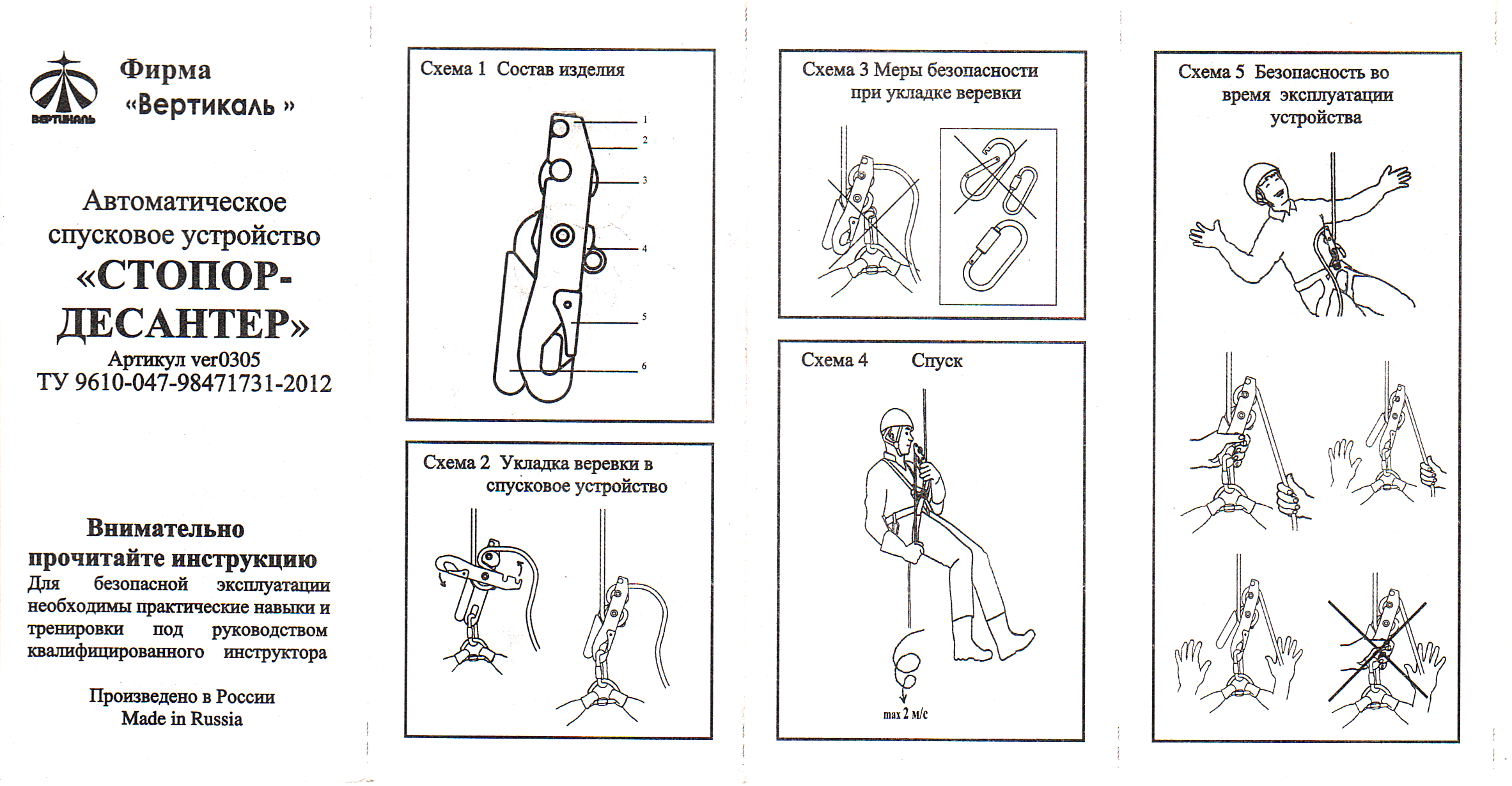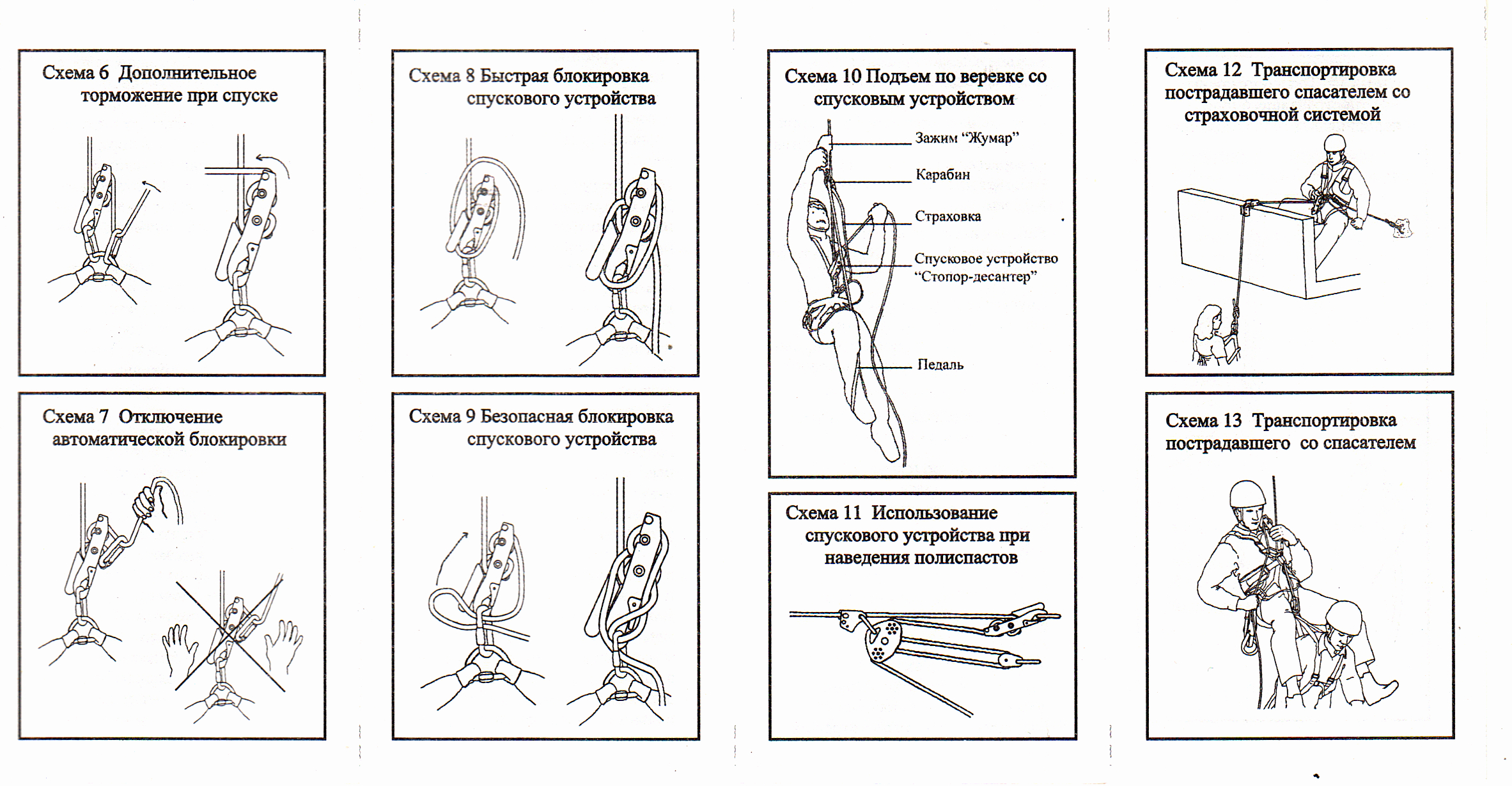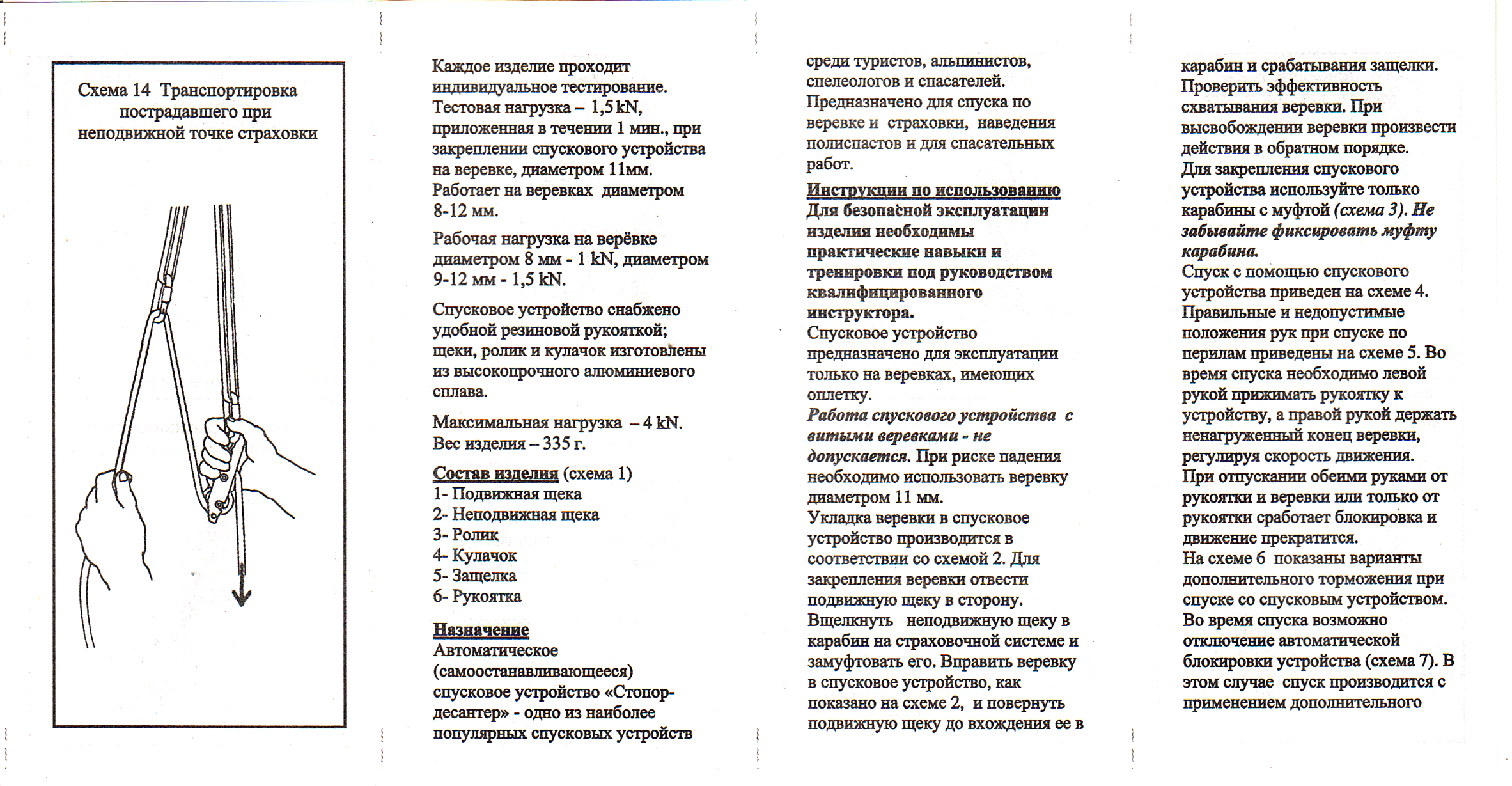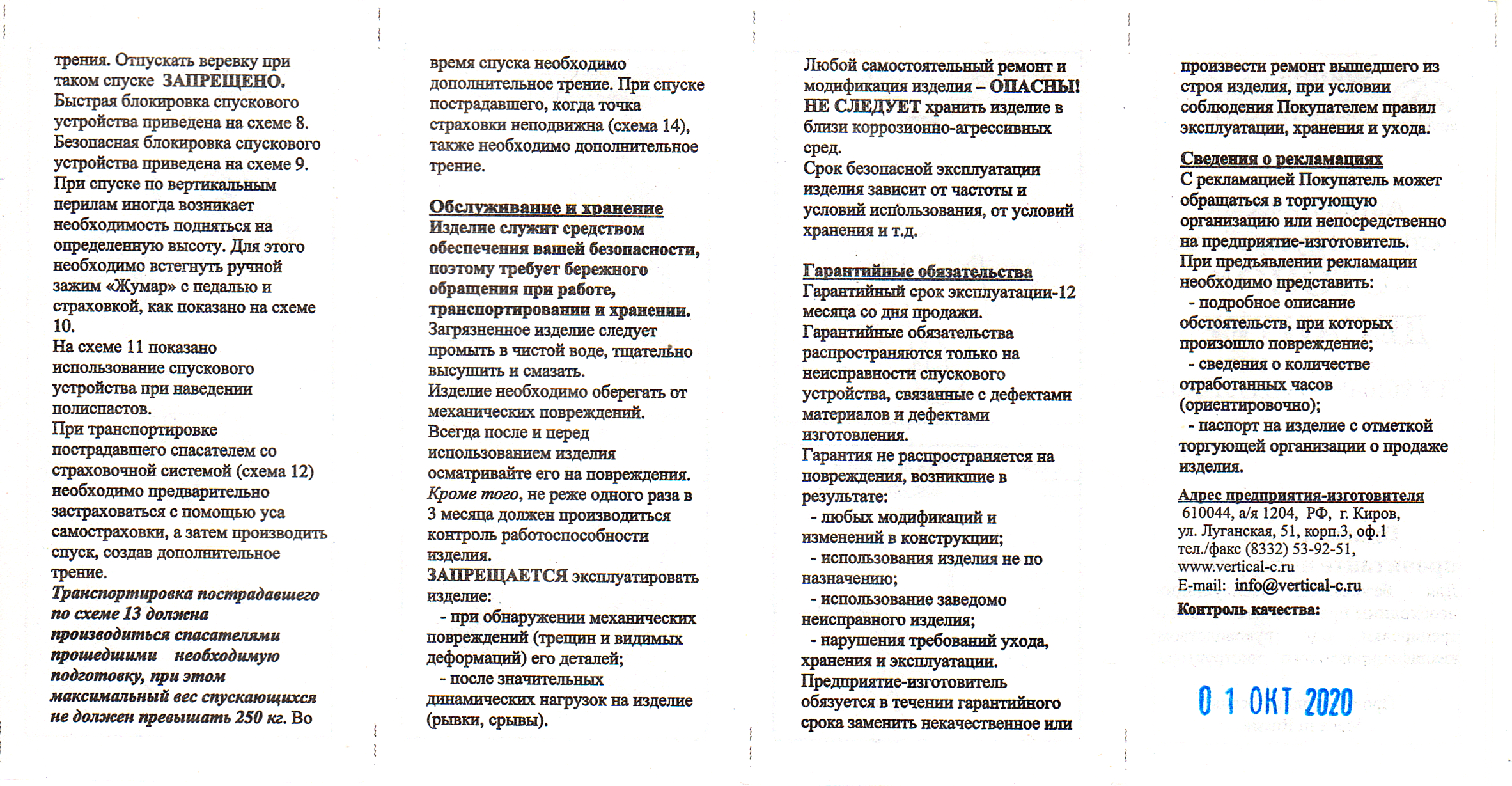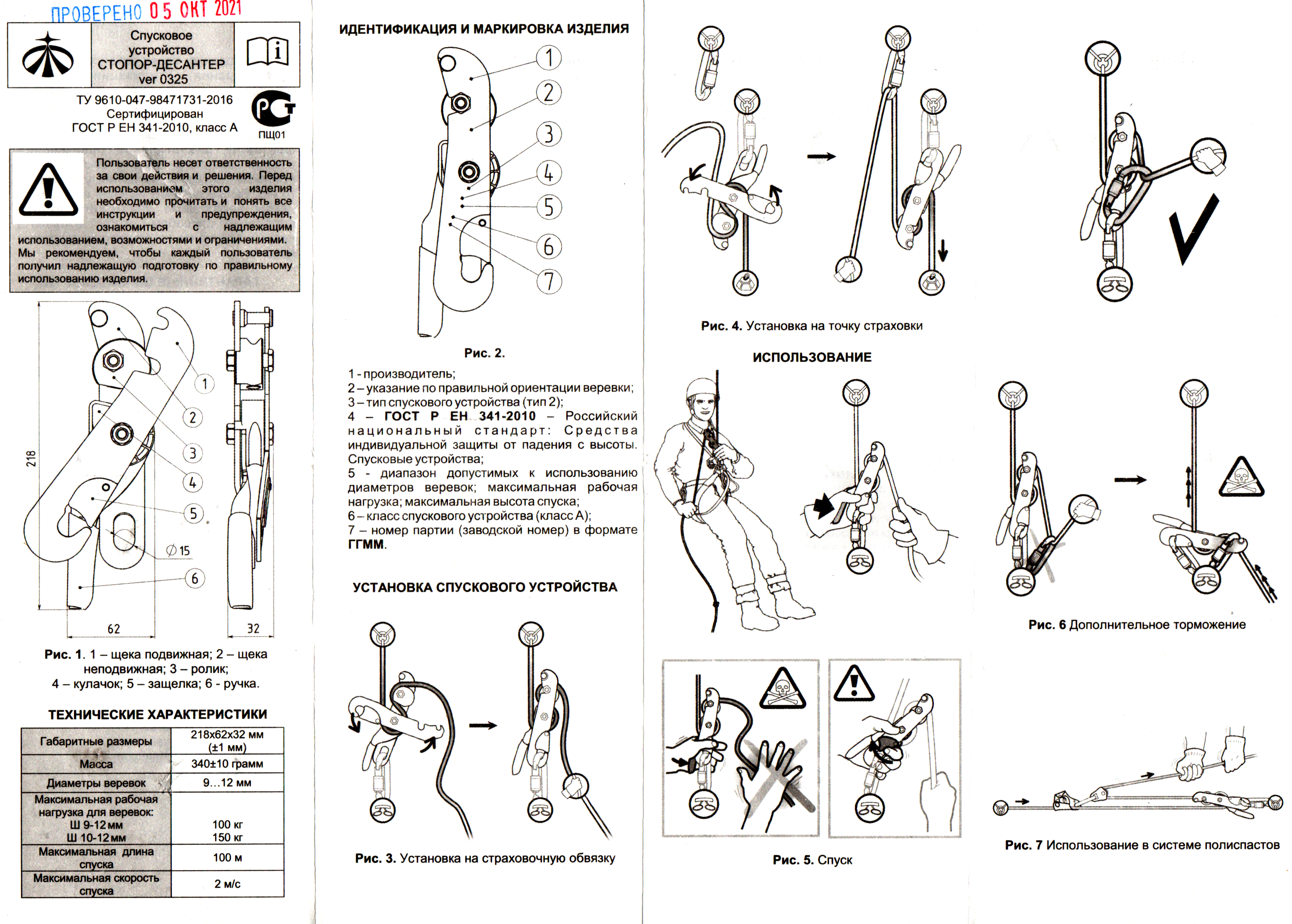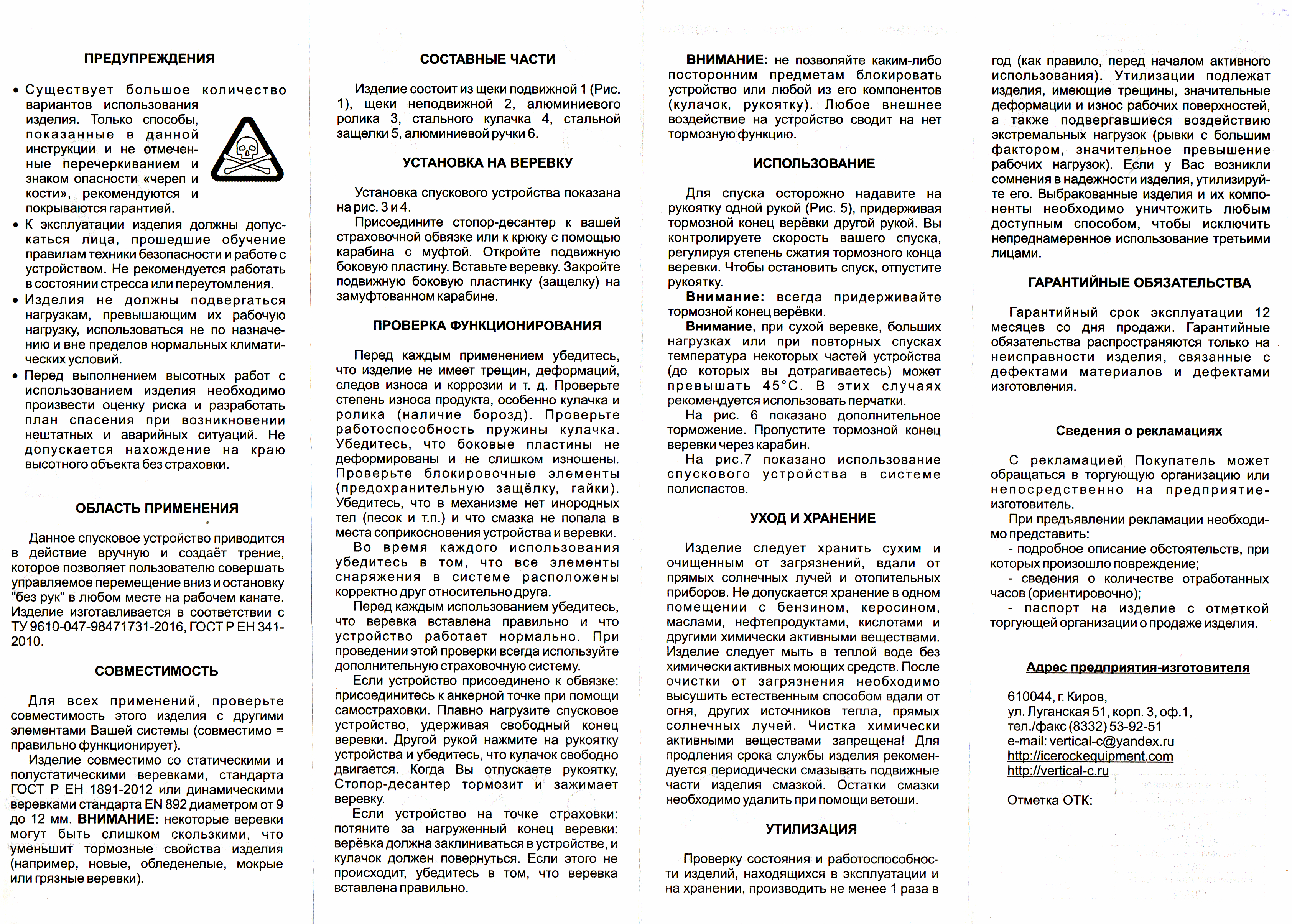Overview
[ Top
| Version B
| Version C
| Return to Stop Bobbins
]
Version A
(#3115)
Technical Details
Artyom Babin (Артём Бабин) sent me this stop bobbin in 2021.
My Vertical is 210 mm. tall, 67 mm. wide, 28 mm. thick, and weighs 391 g.
The two side plates are made of 3.0 mm. aluminum, painted black. One side plate pivots to allow threading the rope. One side plate pivots to allow threading the rope. A small pin extends through the pivoting plate into a slot in the lower bollard. This limits how far the plate can open. Each plate has a short, stamped reinforcement rib near the low err bollard axle. The lower ends of the side plates are bent to converge at the attachment point, which consists of a 14 mm. wide, 30 mm. high hole on the fixed plate and a matching hook on the other. Neither of the attachment points are beveled. The upper portion of the hook is covered by a stamped metal gate. The gate pivots on a steel rivet. There surely was a spring to close the gate, but if so, it is now missing.
The lower bollard is part of an autostop assembly. The upper surface of the bollard is milled flat and a 6 mm. rounded steel block is inset and screwed to the bollard. This protrudes at the 10 o’clock position and acts as a cam much like the cylinder attached to the Diablo. A aluminum handle is riveted to the fixed side plate side of the lower bollard. The handle has a stamped rib for strength and a straight. rubbery plastic hand grip for comfort. The lower bollard and handle assembly rotate on a shoulder nut on the lower bolt. A fairly strong concealed spring tries to keep the handle in the disengaged position. Friction from the main rope’s passage tends to turn the lower bollard and force the toothed cylinder towards the upper bollard, thus locking the rope and ideally arresting the descent. The rappeller uses the handle to keep the autostop feature disengaged. Alternately, a hole in the handle plate opposite the handle itself allows the user to clip a carabiner to disable the autostop feature by preventing rotation of the lower bollard assembly
The upper main bollard is turned aluminum with a milled slot to keep it from rotating on the fixed side plate. The bollard is riveted to the fixed side plate with an 8 mm. semitubular shoulder rivet. The pivoting side plate pivots on the lower bolt and has a slot to allow clearing the upper rivet’s shoulder. The upper bollard has a narrow 9.0 mm. wide, 4.0 mm. deep U-shaped rope groove. The upper bollard is cut away on its lower side to provide a flat surface to act as an anvil for the cam action of the autostop feature. A 10 mm. stainless steel wear pin is pressed into the lower surface.
The third (auxiliary) rod consists of a 12 mm. steel rod turned and pressed into the fixed side plate, and then riveted. Before assembly, a 15 mm. wide surface is turned to 7.9 mm. where the rope runs.
The fixed plate is stamped with "made in Russia." Each side of the has "ВЕРТИКАЛЬ" in raised letters
This is a crude ascender compared to the later version. It is less refined but equally functional (or would be if the gate spring hadn't been lost).
I find the autostop feature to be almost secure, no worse and possibly better than most stop bobbins. It will hold me in position, but I would not count on it stopping an out-of-control rappel any more than I would trust one of the other brands.
[ Top
| Version A
| Version C
| Return to Stop Bobbins
]
Version B
(#2594)
Technical Details
I acquired this Vertical (Вертикаль) stop bobbin from Vertical in 2022.My Vertical (Вертикаль), Version C (ver 0325) is 221 mm. tall, 54 mm. wide, 33 mm. thick, and weighs 343 g.
This bobbin is 221 mm. tall, 54 mm. wide, 33 mm. thick, and weighs 343 g.
The two side plates are made of 3.1 mm. aluminum, painted black. One side plate pivots to allow threading the rope. A small pin extends through the pivoting plate into a slot in the lower bollard. This limits how far the plate can open. The lower ends of the side plates are bent to converge at the attachment point, which consists of a 14 mm. wide, 30 mm. high hole on the fixed plate and a matching hook on the other. Neither of the attachment points are beveled. The upper portion of the hook is covered by a stamped metal gate. The gate pivots on a steel rivet, and a spring set in a deep slot closes the gate.
The lower bollard is part of an autostop assembly. It is an aluminum alloy casting with an integral cam. The lower surface of this bollard has an 9.1 mm. wide, 2.8 mm. deep U-shaped rope groove. The upper surface is flat. A steel handle is attached to the fixed side plate side of the lower bollard with two pins pressed into the bollard. The handle is painted dark reddish-brown and has a brown hard-plastic cover. The lower bollard and handle assembly rotate on a bushing on the 8 mm. lower semitubular rivet. A concealed spring is strong enough to keep the handle in the disengaged position, but is weak enough to function only during storage. Friction from the main rope’s passage tends to turn the lower bollard and force the cam towards the upper bollard, thus locking the rope and ideally arresting the descent. The rappeller uses the handle to keep the autostop feature disengaged. The handle limits the motion by hitting the fixed plate before the lower bollard cam nose contacts the upper bollard.
The upper main bollard is cast aluminum with a slot to keep it from rotating on the fixed side plate. The bollard is riveted to the fixed side plate with an 8 mm. semitubular shoulder rivet. The pivoting side plate pivots on the lower bolt and has a slot to allow clearing the upper rivet’s shoulder. The upper bollard has a narrow 9.0 mm. wide, 4.0 mm. deep U-shaped rope groove. The upper bollard is cut away on its lower side to provide a flat surface to act as an anvil for the cam action of the autostop feature. A 10 mm. stainless steel wear pin is pressed into the lower surface.
The third (auxiliary) rod consists of a 12 mm. steel rod turned and pressed into the fixed side plate, and then riveted. Before assembly, a 15 mm. wide surface is turned to 7.9 mm. where the rope runs.
The fixed plate is printed with the Vertical logo, "VERTICAL," and "4 kN."
This is a reasonably well-made descender, but I dislike the painted side plates. I find that paint on a descender invariably wears off, leaving a mess on the rope.
I find the autostop feature to be almost secure, no worse and possibly better than most stop bobbins. It will hold me in position, but I would not count on it stopping an out-of-control rappel any more than I would trust one of the other brands.
[ Top
| Version A
| Version B
| Return to Stop Bobbins
]
Version C
(#3167)
Technical Details
I acquired this Vertical (Вертикаль) stop bobbin from Artyom Babin (Артём Бабин) in 2020, although it took 2½ months to clear U.S. customs and did not arrive until February 2021.
This bobbin is 210 mm. tall, 74 mm. wide, 29 mm. thick, and weighs 348 g.
The two side plates are made of 3.1 mm. aluminum, painted black. One side plate pivots to allow threading the rope. The lower ends of the side plates are bent to converge at the attachment point, which consists of a 15 mm. wide, 26 mm. high hole on the fixed plate and a matching hook on the other. Neither of the attachment points are beveled. The upper portion of the hook is covered by a stamped metal gate. The gate pivots on a steel rivet, and a spring closes the gate.
The lower bollard is part of an autostop assembly. It is a stainless steel casting with an integral cam . The lower surface of this bollard has an 8 mm. wide, 2 mm. deep U-shaped rope groove. The upper surface is flat. An aluminum handle is attached to the fixed side plate side of the lower bollard with three steel rivets. The handle is painted black and has a black hard-plastic cover. The lower bollard and handle assembly rotate on a bushing on the 8 mm. lower bolt. A concealed spring is strong enough to keep the handle in the disengaged position, but is weak enough to function only during storage. Friction from the main rope’s passage tends to turn the lower bollard and force the cam towards the upper bollard, thus locking the rope and ideally arresting the descent. The rappeller uses the handle to keep the autostop feature disengaged. A pin extension on the rear of the bollard casting limits the handle motion by hitting the fixed plate before the lower bollard cam nose contacts the upper bollard.
The upper main bollard is aluminum, painted black, with a slot to keep it from rotating on the fixed side plate. The bollard is attached to the fixed side plate with an 8 mm. bolt and a shoulder nut. The pivoting side plate has a slot to allow clearing nut’s shoulder. The upper bollard has a 9.8 mm. wide, 4.2 mm. deep U-shaped rope groove. The upper bollard is cut away on its lower side to provide a flat surface to act as an anvil for the cam action of the autostop feature. A 10 mm. stainless steel wear pin is pressed into the lower surface.
The third (auxiliary) rod consists of a 12 mm. steel rod turned and pressed into the fixed side plate, and then riveted. Before assembly, a 15 mm. wide surface is turned to 7.9 mm. where the rope runs.
The fixed plate is printed with the Vertical logo, "VERTICAL," a rigging illustration, "ТИП 2," "ГОСТ Р ЕН 341-2010," "Ø 9-12 мм 100 кг 100 м," "Ø 10-12 мм 150 кг 100 м," "КЛАСС А," and 1811. The bolt heads have "5.8" and two other raised symbols that I do not recognize.
This is a reasonably well-made descender, but I dislike the painted side plates and detest the painted bollard. I find that paint on a descender invariably wears off, leaving a mess on the rope.
I find the autostop feature to be almost secure, no worse and possibly better than most stop bobbins. It will hold me in position, but I would not count on it stopping an out-of-control rappel any more than I would trust one of the other brands.
[ Top
| Version A
| Version B
| Version C
]



